Introduction
Over the past decade, state government facilities have helped to increase the deployment of renewable energy in Massachusetts by installing a variety of technologies at their own facilities, including solar PV, wind, and a range of renewable thermal technologies such as solar thermal, modern wood heating systems, and air- and ground-source heat pumps. More recently, state facilities have begun to deploy battery energy storage, often pairing these systems with solar PV installations.
Installing onsite renewable, distributed energy systems and battery energy storage helps reduce state facility energy costs, lowers demand on the grid, enhances site energy resilience, and helps advance the Commonwealth's clean energy goals. In addition, by replacing onsite fossil-fuel heating systems with renewable thermal technologies, facilities are taking steps to decarbonize their operations and take advantage of the Commonwealth's greening grid.
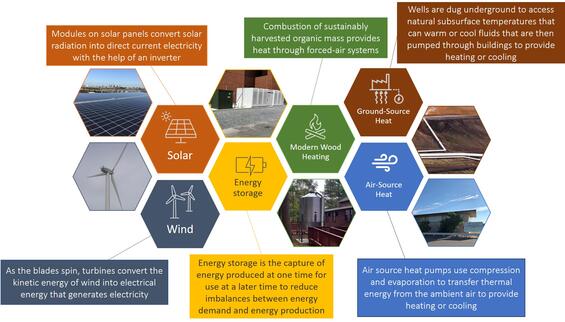
State facilities have installed an array of renewables to generate electricity and/or thermal energy. Renewable electricity resources, such as solar PV and wind, harness the conversion of natural resources into electrical energy. Renewable thermal technologies, such as modern wood heating systems that rely on sustainably harvested biomass materials, solar thermal arrays, and heat pumps designed to work in cold weather, efficiently generate thermal energy without the use of fossil fuels. Energy storage can be used to store either electricity or thermal energy.
Executive Order 594 sets the stage for continued expansion of renewable energy and storage at state facilities. Under the Order's LEED Plus 2.0 Building Standard, new state construction and substantial renovation projects are required to use only efficient electric or renewable thermal technologies, and maximize the installation of onsite renewable technologies. Where appropriate, existing facilities are also directed to expand deployment of renewables and battery storage. See the Executive Order 594 Section 6 Guidelines for additional details.
More information on the growth of renewables at state facilities can be found on the LBE Progress Dashboard & Reports page and the Sustainability Initiatives at State Facilities page.
Solar PV
There are currently more than 34 megawatts (MW) of solar capacity installed across 44 state facilities and properties. Since 2010, much of the increase in solar PV deployment has come in the form of solar canopies, which now make up 57% of all installed solar capacity at state sites, many of which also include electric vehicle charging stations. Rooftop and ground-mounted systems make up roughly equal amounts of the remaining total.
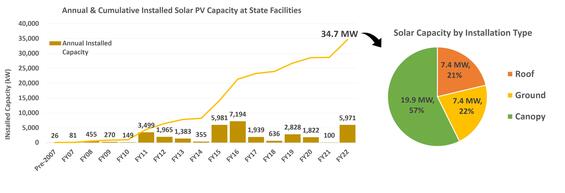
Solar canopy systems (which are commonly installed over parking areas) comprise 57% of state facility solar capacity, with roof and ground mount systems making up relatively equal portions of the remaining installations. Along with onsite solar generation, some LBE partners utilize net-metering agreements to procure renewable energy credits from offsite solar PV installations.
State entities have utilized both ownership and third-party owned power purchase agreement (PPA) models for their onsite renewable systems. Owned systems require more upfront capital to install but result in greater energy savings and full access to solar incentives. PPAs require little to no upfront investment, resulting in lower energy costs, while the 3rd party developer takes advantage of the tax credits and solar incentives.
Along with onsite solar generation, some LBE partners utilize virtual net-metering agreements to support the installation of offsite solar PV and procure energy credits from those installations, helping to reduce their electricity bills.
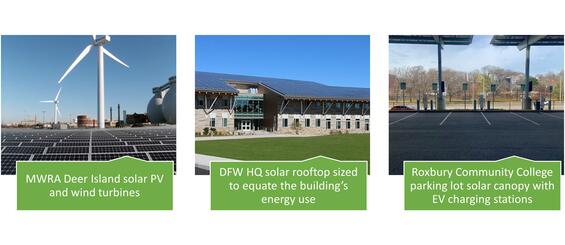
Renewable electricity generation at state facilities comes in many forms and configurations.
Other Renewables
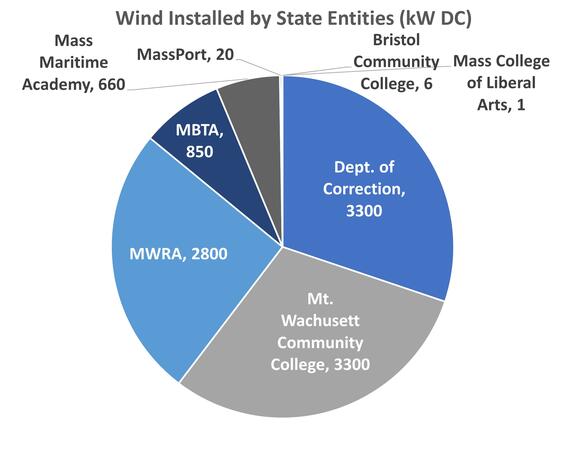
Eight state entities have installed wind turbines across eleven sites.
In addition to solar PV, eight state facilities have installed 11 MW of wind turbines and the 19 MW MWRA anaerobic digester at Deer Island significantly reduces the wastewater treatment facility’s demand on grid electricity.
Renewable Thermal
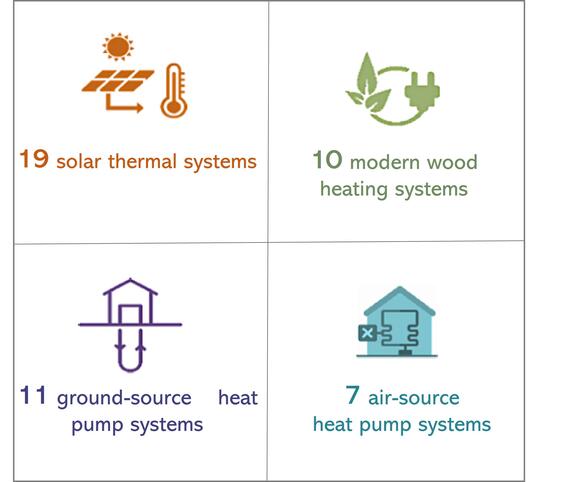
Renewable resources can offer several benefits for state facilities, including but not limited to reducing regional GHG emissions, decreasing overall energy costs, enhancing energy resilience, and providing a visible commitment to leadership in clean energy efforts.
Renewable thermal systems are critical to help state facilities move away from on-site combustion of fossil fuels for space heating. As of March 2022, 47 renewable thermal installations have been installed across the state portfolio and include air- and ground-source heat pumps, solar thermal, and modern wood heating systems with sustainably-sourced fuel.
The LBE program leverages existing facility energy data and collaborates with DCAMM and other agency partners to identify opportunities for conversion to efficient electric or renewable thermal technologies, particularly before fossil fuel-powered systems approach the end of their useful lives and require replacement. These technologies continue to be a primary area of focus per Executive Order 594, which directs the use of efficient electric or renewable thermal heating, cooling, and water heating for both new and existing facilities.
Energy Storage
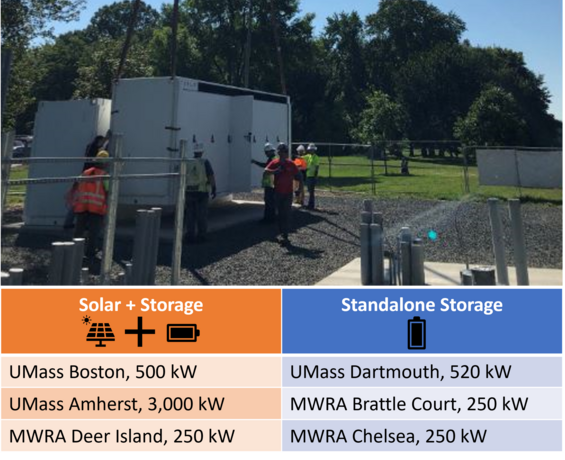
Sixfacilities have installed battery energy storage systems, either standalone or paired with solar, representing a combined total of 4.77 MW. Image: A 2,000 kW/4,000kWh battery installed at UMass Amherst, summer 2021.
A small but growing number of state facilities have deployed battery energy storage systems (BESS) to improve facility resilience and reduce grid electricity demand at peak periods. State entities are pairing BESS with solar installations when possible and designing projects to support an appropriately sized storage solution in the future.
LBE Program staff are also working with key state partners to identify and target sites with significant energy demand and electricity costs that would benefit from BESS. The Resources section below includes details on available incentive programs to support these efforts.
Resources
Funding and Incentives
| Funding Type | Resource |
|---|---|
| Solar | Leading by Example Grants⇒ LBE grant programs include funding for solar PV and clean energy feasibility studies at state facilities. Applications are accepted on a rolling basis. |
| Solar | Solar Massachusetts Renewable Target (SMART)⇒ Administered by DOER, this program provides incentives for solar PV and accompanying energy storage systems. |
| Renewable Thermal | Alternative Energy Portfolio Standard (APS) ⇒ Administered by DOER, the APS provides requirements and incentives for alternative electricity technologies such as air- and ground-source heat pumps, solar thermal, woody biomass, advanced liquid biofuels, biogas, and compost heat exchange systems. |
| Battery Storage | Clean Peak Energy Standard ⇒ Administered by DOER, this program provides incentives to clean energy technologies that can supply electricity or reduce demand during seasonal peak demand periods established by DOER. |
| Battery Storage | ConnectedSolutions (Eversource and National Grid) ⇒ Residential and commercial programs through Mass Save offer incentives to entities for dispatching electricity from their batteries during periods of peak demand. |
| Battery Storage | Mass Save Demand Response & Storage ⇒ Homes and small businesses earn incentives for allowing the grid to draw energy stored in batteries during times of peak electricity demand. |
Background Information and Additional Funding Resources
- DOER Renewable Energy Division ⇒ The Renewable Energy Division website includes information on various incentive programs, clean energy standards, and introductory information on solar, energy storage, and others.
- MassCEC Commercial Solar ⇒ The Massachusetts Clean Energy Center has compiled information about how solar works, available incentives, costs and performance, and more.
- Renewable energy already comprises a growing portion of power generation within the Commonwealth. This increase is driven in part by existing state policies and programs intended to reduce emissions in line with the 2008 Global Warming Solutions Act, including the Renewable Portfolio Standard, Alternative Portfolio Standard, and the Clean Energy Standard among others. The continued deployment of renewables across the region will be critical to support the widespread electrification of the building and transportation sectors as outlined in the 2030 Clean Energy and Climate Plan.
- U.S. DOE Office of Electricity Energy Storage Program ⇒ Federal projects, resources, and news related energy storage.
Solar PV Ownership and PPAs
- All the Sun Without the Stumble slides ⇒ PowerOptions can conduct solar feasibility studies for state agencies without cost and can provide a pathway to solar procurement without the need to go to bid. Contact Leading by Example Program staff for more information.
Tracking and Energy Use Guidance
- MassCEC Production Tracking System ⇒ This system lets state facilities register their installations, track the amount of electricity being produced, and more. Note that a log-in is required.
- U.S. Environmental Protection Agency’s Solar Power Use Claims Guidance ⇒ Recommended best practices in making renewable energy use claims.
Solar Siting and Development
- National Renewable Energy Laboratory REopt Lite Tool ⇒ This tool allows users to evaluate opportunities for onsite solar PV, wind, battery storage, and thermal energy storage, and may serve as a starting point for entities seeking to determine general feasibility of renewable options.
- MassCEC Resiliency Toolkit ⇒ Integrating renewable energy into facilities and community electric grids can help make them more resilient during outages. The MassCEC Clean Energy and Resiliency (CLEAR) program developed a toolkit to help facilities conduct a preliminary analysis of the cost and resources that would be required to undertake such a project before hiring a consultant.